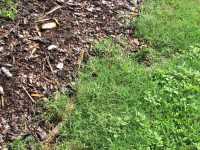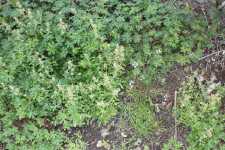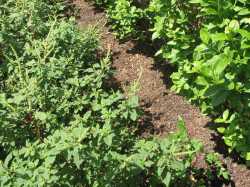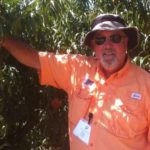Weed Management Options In Blueberries

Establishing and maintaining an effective weed management program is one of the most important factors in obtaining optimum commercial blueberry yield and quality. While insects, plant pathogens and other pests occasionally attack commercial plantings, a blueberry producer can always expect weed pressure to be a challenge, no matter what production system is being utilized.
Blueberry growers who initiate planning their weed management program long before establishing a new planting or rejuvenating an established field or farm will have the highest probability of efficiently managing these pests. The following sections will describe some common weeds encountered in Florida Blueberry Farms and tactics that will assist growers to manage weed populations in their farms.
In organic production, weed management is often a very costly operation, as there are a very limited number of herbicides approved for organic production. The herbicides that are available are often very costly and have limited efficacy, as they mainly burn the actively growing plant tissue on which they are applied. For these reasons, it is essential for organic blueberry producers to take all steps necessary to prevent weed infestations from becoming established.
Proper Weed Identification
As with any pest a blueberry grower encounters in their field, proper identification of weedy species present in the field is the first step to initiating a successful weed management program. Once a grower identifies a weed species, he can obtain information about the time of year to expect it to infest his fields and what control tactics will be effective in its management.
Types Of Weeds Encountered
Perennial and biennial weeds – Perennial weeds are those that can survive for several years. These weedy pests may be present all year or be dormant during the winter, only to begin regrowth with the advance of warmer temperatures in the spring. An example of a perennial species which can be a weedy pest of blueberry farms is common Bermudagrass (Cynodon dactylon). Bermudagrass can often be a serious pest when new blueberry fields are established in old pastures or hay fields.
Some other common perennial weeds encountered by blueberry growers:
Nutsedges:
- Yellow (Cyperus esculentas)
- Purple (C. rotundus)
- Green brier (Smilax spp.)
- Curly dock (Rumex crispus)
- Red sorrel (Rumex acetosella)
Biennial weeds complete their life cycle in two years. Typically in the first year they have low vegetative growth when a deep taproot is generally formed, followed by the emergence of a flowering shoot in the second year.
Some biennial weeds that may be encountered in blueberry farms are:
- Wild carrot (Daucus carota)
- Carolina false dandelion (Pyrrhopappus carolinianus)
- Common mullein (Verbascum thapsus)
Annual weeds – Annual weeds establish and generally complete their life cycle in a 12 month or shorter period. Annual weeds often can be separated into two groups; summer and winter annuals. Winter annuals are those that many blueberry growers encounter from the dormant period through harvest. Summer annuals are mainly a pest from post-harvest through the fall.
There is typically a diverse mix of mainly broadleaf winter annual plants infesting Florida blueberries. Some common winter annual weeds observed in commercial blueberry plantings:
- Asiatic hawksbeard (Youngia japonica)
- Carolina geranium (Geranium carolinianum)
- Cudweeds (Gnaphalium spp.)
- Cutleaf eveningprimrose (Oenothera laciniata)
- Oldfield toadflax (Linaria canadensis)
Weed Management Options In Blueberries ctd.

During the summer, common annual grasses and broadleaves such as pigweeds are observed germinating and establishing in commercial blueberry fields. Some other common summer annual weeds in blueberry fields are:
- Annual sedges (Cyperus spp.)
- Crabgrasses (Digitaria spp.)
- Chamberbitter (Phyllanthus urinaria)
- Florida pusley (Richardia scabra)
- Spurges (Chamaesyce spp.)
Preventing Weed Problems
Preventing weedy plant species from growing and spreading in a blueberry farm is a goal all growers should take to avoid chronic weed problems from becoming established on their farms. Those establishing new blueberry plantings have the best chance of achieving this goal but it is also attainable for established farms or those re-planting a block. Some ways to prevent weed infestations are discussed below.
Prevent weeds from going to seed – The majority of weeds infest plantings by seed introduction into the plant beds. Weedy species are known to produce large number of seeds, some as high as 5,000 to 10,000 per plant. Considering the fact that some weed species can lay dormant in the soil until the appropriate requirements for germination in the environment are met and the sheer number of seed produced by some weeds, it is imperative to prevent further weed seed introduction.
Weed seed may come from weedy species already established in the bed, those in row middles or plants on the boundaries of a field. Weed management tactics, such as the use of herbicides, can eliminate weeds before they go to seed and thus prevent them from adding seeds to the reservoir already in the field. Maintaining row middles and field borders by mowing or other tactics can reduce the number of weed seed that can potentially be spread to the blueberry beds.
Always use clean planting stock – Most growers know that they need to have planting stock free of insects and plant pathogens but it is equally important to certify planting material is also weed free. Weed infested plant material is an extremely effective means to introduce a new weed problem into your field. It is advised to inspect nursery material for weeds and other pests before accepting delivery.
Manage perennial weeds before planting – Perennial weeds such as nutsedge and bermudagrass are very difficult to manage in a blueberry planting without the risk of sustaining crop injury. Organic producers should certainly manage perennials before planting, as there are few, if any, effective herbicides available to them. It is recommended to manage perennial species before planting, if possible.
Non-Chemical Management
A common tactic for non-chemical weed management is mowing weeds off before they have a chance to produce viable seed. Cultivation of the soil, weed eating and hand pulling are some other non-chemical tactics utilized by blueberry growers.
Weed Management Options In Blueberries ctd.

Many growers are utilizing plastic mulches or woven ground covers to prevent weed populations from becoming established in their fields. This is growing in popularity with organic growers. Growers should know what soil temperatures are possible below plastic mulches and possibly plant only during the cooler months to avoid damaging temperatures in the root zone.
Irrigation method has an effect on weed populations. Low volume systems such as drip and microsprinklers direct water to the crop root zone and not to other portions of the field where weedy plant species may become established.
Managing Weeds With Herbicides
The majority of commercial blueberry growers utilize herbicides as one of their weed management tactics. When determining which herbicide to use in a program, the most important factor is to have an accurate identification of all weed species in the field. Once identification is complete, there are several factors about herbicides that growers need to know.
Contact vs. residual weed activity – A contact herbicide will cause phytotoxicity to susceptible plants when spray solutions come in contact with plant parts. Most contact herbicides approved for use in commercial blueberries can harm the crop, if applied to susceptible portions of blueberry plants. Instructions explaining the importance of applying these products in a method where no contact to susceptible portions of the crop plant are included in the product label.
Residual herbicide products (often called preemergence) act upon germinating weedy species and prevent them from establishing. Many residual herbicides will have little to no activity on weeds, if applied after the weed seeds have germinated and begun to grow.
Some residual herbicides will also have limited contact activity on certain weeds, which is generally detailed on the product labeling. Product labeling on certain residual herbicides will have statements indicating it is necessary to apply the product in a manner which avoids contact with susceptible parts of the crop to avoid potential injury.
Selective vs. non-selective herbicides – Generally a selective herbicide has activity on weed species present in the field, with little to no detrimental effects on the host crop. It should be noted that some herbicides considered selective may harm the crop, if applied inconsistent to instructions on the product label.
Sources of information about herbicides – The only source for complete information about herbicides labeled for use in commercial blueberry plantings is the product label. UF/IFAS Extension has a publication entitled Weed Management in Blueberry (HS 90) on the on-line EDIS System (http://edis.ifas.ufl.edu) which has general recommendations about herbicides approved for use in blueberry. This document is a good source for general information about recommended herbicides but the individual herbicide product labeling contains all of the information about using the product. All product label instructions must be followed to be in compliance with Federal Law covering pesticide applications.
Summary
Blueberry growers who realize the importance of taking steps to prevent weed infestations from establishing and spreading in their plantings and take action to prevent such, should have fewer weed problems than those that do not. Eliminating potential perennial weed problems before establishing a planting and utilizing various tactics that prevent annual weedy species either in or around their plantings from going to seed should lead to lower populations in the field.
0
1
5
Weed Management Options In Blueberries










